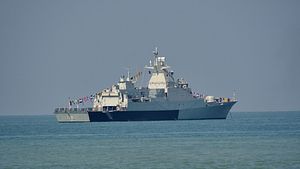On November 4, in Kuala Lumpur, the Japanese and Chinese defense ministers met for the first time since June 2011. During their meeting, Japanese Defense Minister Gen Nakatani and Chinese Defense Minister General Chang Wanquan affirmed the importance of a maritime communication mechanism to prevent accidental clashes at sea and in the air, and agreed to the early launch of such a mechanism.
After the meeting, Nakatani commented, “Defense cooperation and exchanges [between Japan and China] are necessary for stability in the Asian region… I want to make further efforts to call for such talks in order to develop our relationship.”
However, rhetoric outpaced substance at the meeting: the two sides did not make much progress in establishing the mechanism, did not set up a timeline for the implementation of such a mechanism, and could not agree on whether the proposed mechanism should or should not include the Senkaku/Diaoyu Islands, which are claimed by both Japan and China. Tokyo does not want the mechanism to cover the Senkaku/Diaoyus because they maintain that there is no dispute over the islands, while Beijing wants the mechanism to cover a wider area, including the Senkaku/Diaoyus.
Negotiations over a maritime communication mechanism have been long-running and are proceeding on multiple tracks. There is the Japan-China Maritime Communications Mechanism (JCMCM), the Maritime Search and Rescue Cooperation Agreement (SAR Agreement), and the High-Level Consultation on Maritime Affairs (High-Level Consultations). Each proposed agreement has a slightly different purpose: the JCMCM is primarily a defense arrangement, the SAR Agreement a civilian arrangement, and the High-Level Consultation a forum to bring together a myriad of stakeholders in a whole-of-government effort. Each agreement has been proceeding – on again, off again – on its own schedule. (For more details on the three different tracks, see the 2013 study, “Japan-China Maritime Confidence Building and Communications Mechanisms,” published by Pacific Forum CSIS).
Negotiations over the JCMCM, which is what the phrase “maritime communication mechanism” most commonly refers to, began in April 2008. The JCMCM’s military nature limits its utility somewhat – even if it were to be signed and implemented – because many of the most recent incidents involve non-military Chinese vessels.
After meetings in November 2009, July 2010, and June 2012, the two sides agreed in principle to (1) annual meetings to include working-level discussions, (2) a hotline to enable crisis communications, and (3) an agreement for People’s Liberation Army Navy (PLAN) and Japan Maritime Self Defense Forces (JMSDF) vessels to communicate in English on VHF radio channel 16 or use signal flags when they can during encounters. The last point is redundant, and can hardly be considered a “breakthrough,” because Japan and China are already signatories to the International Regulations for Preventing Collisions at Sea (COLREGS) and the Code for Unplanned Encounters at Sea (CUES) agreement, which stipulate their respective naval forces should communicate using English on channel 16 or signal flags.
Negotiations stalled following the Japanese government’s nationalization of the Senkaku/Diaoyu Islands in September 2012. But a January 2013 incident, in which a Chinese destroyer electronically targeted a Japanese destroyer, led to another meeting in April 2013 at the director-general level.
The next round of working-level talks were not held until January 2015, when Japan and China aimed to hammer out the details of the hotline, and the discussions continued in March 2015. The “Four Point Consensus” behind Japanese Prime Minister Shinzo Abe and Chinese President Xi Jinping’s November 2014 meeting was an important foundation for the continuation of these discussions.
The January meeting yielded a significant development: the change in scope from just a maritime communication mechanism to maritime and aerial communication mechanism. Incidents in the air are an increasing concern, as the number of Japanese jet fighters scrambling against Chinese intrusions has increased since China unilaterally declared an Air Defense Identification Zone (ADIZ) in November 2013.
Meetings froze again in June, when Japan insisted that the agreement not cover territorial waters or airspace — and China refused. Japan wants to exclude territorial waters and airspace because, as a Japanese government source told The Chicago Tribune, “If territorial waters and airspace were included, it would send the wrong message that if Chinese military ships or planes wanted to intrude around the Senkaku Islands, all they needed to do is let Japan know.” Another reason for the freeze in discussions might have been China’s desire to use a potential agreement as leverage to shape Abe’s war anniversary statement that upcoming August.
The JCMCM is modeled on the United States-China Military Maritime Consultative Agreement (MMCA), which may be problematic. As Marta McLellan Ross, a Council on Foreign Relations International Affairs Fellow in Japan, points out, the MMCA does not include a commitment by the two sides to refrain from provocative behavior. Ross explains:
In reality, … a collision is unlikely to occur with air or naval operators from professional, modern militaries unless one of the parties is engaged in behavior contrary to internationally accepted Rules of the Road – either by negligence or intent. In most cases, the avoidance of a collision is largely a political problem. … Without a political commitment to avoid collisions and support crisis management, the process established by the MCM risks being derailed every time political tensions between Japan and China flare up.
The stop and go nature of Japan-China negotiations, as well as the lack of a codified commitment to refrain from risky behavior, illustrate how managing tension in the East China Sea is ultimately a matter of political will. The greatest significance of actually signing the JCMCM may be more political than operational.
Of course, Japan and China remain worlds apart on the question of sovereignty over the Senkaku/Diaoyu Islands, and tensions will continue so long as the dispute festers. But signing the JCMCM would signal both Japan and China’s commitment to manage the dispute – and shield the processes by which their respective forces deal with each other from the vagaries of their broader political relationship.

































